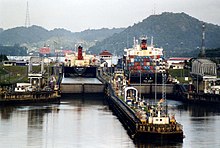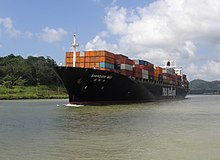Panamax

Panamax and New Panamax are terms for the size limits for ships traveling through the Panama Canal. Formally, these limits and requirements are published by the Panama Canal Authority (ACP), titled "Vessel Requirements".[1] These requirements also describe topics like exceptional dry seasonal limits, propulsion, communications, and detailed ship design.
The allowable size is limited by the width and length of the available lock chambers, by the depth of water in the canal, and by the height of the Bridge of the Americas since that bridge's construction. These dimensions give clear parameters for ships destined to traverse the Panama Canal and have influenced the design of cargo ships, naval vessels, and passenger ships.
Panamax specifications have been in effect since the opening of the canal in 1914. Ships that do not fall within the Panamax-sizes are called post-Panamax. In 2009 the ACP published the "New Panamax"[2] that will be in effect when the canal's third set of locks, larger than the current two, becomes operational.
The increasing prevalence of vessels of the maximum size is a problem for the canal, as a Panamax ship is a tight fit that requires precise control of the vessel in the locks, possibly resulting in longer lock time, and requiring that these ships transit in daylight. Because the largest ships traveling in opposite directions cannot pass safely within the Culebra Cut, the canal effectively operates an alternating one-way system for these ships.
Dimensions



Panamax is determined principally by the dimensions of the canal's lock chambers, each of which is 110 ft (33.53 m) wide, 1,050 ft (320.04 m) long, and 41.2 ft (12.56 m) deep. The usable length of each lock chamber is 1,000 ft (304.8 m). The available water depth in the lock chambers varies, but the shallowest depth is at the south sill of the Pedro Miguel Locks and is 41.2 ft (12.56 m) at a Miraflores Lake level of 54 ft 6 in (16.61 m). The height of the Bridge of the Americas at Balboa is the limiting factor on a vessel's overall height; the exact figure depends on the water level.
The maximum dimensions allowed for a ship transiting the canal are:[1]
Length
Overall (including protrusions): 950 ft (289.56 m). Exceptions:
- Container ship and passenger ship: 965 ft (294.13 m)
- Tug-barge combination, rigidly connected: 900 ft (274.32 m) overall
- Other non-self-propelled vessels-tug combination: 850 ft (259.08 m) overall;
Width (beam)
Width over outer surface of the shell plating: 106 ft (32.31 m). General exception: 107 ft (32.61 m), when draft is less than 37 ft (11.3 m) in tropical fresh water.
Draft
39.5 ft (12.04 m) in Tropical Fresh Water (TFW). The name and definition of TFW is created by ACP using the freshwater Lake Gatún as a reference, since this is the determination of the maximum draft. The salinity and temperature of water affect its density, and hence how deep a ship will float in the water. Tropical Fresh Water (TFW) is fresh water of Lake Gatún, with density 0.9954 gms/cc [0.9954 g/cm3], at 29.1 °C (84 °F).[3] The physical limit is set by the lower (seaside) entrance of the Pedro Miguel locks. When the water level in Lake Gatún is low during an exceptionally dry season the maximum permitted draft may be reduced. Such a restriction is published three weeks in advance, so ship loading plans can take appropriate measures.
Air draft
190 ft (57.91 m) measured from the waterline to the vessel's highest point; limit also pertains to Balboa harbor. Exception: 205 ft (62.5 m) when passage at low water (MLWS) at Balboa is possible.
All exceptions are typically allowed only after specific request and an investigation, and on a once- or twice-only basis.
A Panamax cargo ship would typically have a DWT of 65,000–80,000 tonnes, but its maximum cargo would be about 52,500 tonnes during a transit due to draft limitations in the canal.[4]
The longest ship ever to transit was the San Juan Prospector, now the Marcona Prospector, an ore-bulk-oil carrier that is 973 ft (296.57 m) long, with a beam of 106 ft (32.31 m).[5] The widest ships to transit are the four Template:Sclass- (Iowa, New Jersey, Missouri, and Wisconsin), which have a maximum beam of 108 ft (33 m), leaving less than 6 in (15 cm) margin of error between the ships and the walls of the locks.[6]
Post-Panamax ships
Post-Panamax or over-Panamax denote ships larger than Panamax that do not fit in the canal, such as supertankers and the largest modern container and passenger ships. The first known post-Panamax ships were the Japanese Yamato-class battleships.[7][8]
Context
As early as the 1930s, new locks were proposed for the Panama Canal to ease congestion and to allow larger ships to pass. The project was abandoned in 1942.
On October 22, 2006, the Panama Canal Authority (with the support of the Electoral Tribunal) held a referendum for Panamanian citizens to vote on the Panama Canal expansion project. The expansion was approved by a wide margin, with support from about 78% of the electorate. It is estimated that the project will be completed by 2015 and will cost $5.3 billion; this sum is expected to be recovered within 11 years.
New Panamax
The plans to build another set of larger locks, have led to the creation of New Panamax, based on new lock dimensions of 427 m (1,401 ft) in length, 55 m (180 ft) in beam, and 18.3 m (60.0 ft) in depth.[2] Naval architects and civil engineers are already taking into account these dimensions for container ships.[9] After this expansion, the Panama Canal will be able to handle vessels of cargo capacity up to 13,000 twenty-foot equivalent units (TEU);[10] currently, it can only handle vessels up to about 5,000 TEU.[11] The New Panamax standard will be able to accommodate ships up to 120,000 DWT.[12]
However, even after opening the new, much larger locks, there will be ships that will not be able to pass through the Panama canal. These include Maersk E-class and Maersk Triple E class container ships, TI class supertankers, and Valemax ore carriers, all of which are too wide for the new locks. Furthermore, while the world's largest cruise ships, Oasis of the Seas and Allure of the Seas, will fit within the new locks, they are too tall to pass under the Bridge of the Americas even at low tide.
Several ports, including the ports of New York and New Jersey, Norfolk, and Baltimore, all on the east coast of the United States, have already increased their depth to at least 50 feet (15 m) to accommodate these changes; the Port of Miami has recently approved the same in a project known as the "Deep Dredge"[13] and will be the closest deep-water port to the Panama Canal in the US. Liverpool is building a new container terminal, Liverpool2, where ships berth in the tidal river rather than in the enclosed docks, to coincide with the opening of the widened Panama Canal locks. The Port Authority of New York and New Jersey is planning to raise the clearance of the Bayonne Bridge to 215 feet (66 m), at a cost of $1 billion, to allow New Panamax ships to reach container port facilities at Port Newark-Elizabeth Marine Terminal. As of April 2012, a controversy between Savannah, Georgia, and Charleston, South Carolina, over limited federal funding for dredging/deepening projects—including both state and federal lawsuits filed by environmental groups in both states opposing the techniques planned to be used in dredging the Savannah River—also revolves around attracting the business of carriers whose fleets include New Panamax vessels. Jacksonville, Florida, is pursuing its "Mile Point" project with the prospect of deepening the St. John's River in anticipation of Post-Panamax traffic; Mobile, Alabama, has completed the deepening of its harbor to 45 feet (14 m) for the same reason; and other ports seem likely to follow suit.
Comparison of sizes

| Locks | Panamax | Third locks [n 1] | Neo Panamax[n 1] | |
|---|---|---|---|---|
| Length | 1,050 ft (320.04 m) | 965 ft (294.13 m) | 427 m (1,400 ft) | 366 m (1,200 ft) |
| Width | 110 ft (33.53 m) | 106 ft (32.31 m) | 55 m (180 ft) | 49 m (161 ft) |
| Draft[n 2] | 41.2 ft (12.56 m) | 39.5 ft (12.04 m) | 18.3 m (60 ft) | 15.2 m (50 ft) |
| TEU | 5,000 | 12,000 | ||
| ||||
See also
- List of Panamax ports
- Valemax - bigger ships
- Chinamax - bigger port profile
References
- ^ a b "Vessel Requirements" (PDF). Panama Canal Authority..
- ^ a b c Manuel E. Benítez, ACP (2009-01-19). "Dimensions for Future Lock Chambers and "New Panamax" Vessels" (PDF). ACP. Retrieved 2010-05-02.
- ^ "Regulation on navigation in Panama Canal Waters" (PDF). The Panama Canal Authority. 1999-06-03. p. 10. Retrieved 2012-12-10.
- ^ Modern ship size definitions (PDF), Lloyd's register.
- ^ Background of the Panama Canal, Montclair State University.
- ^ "BB-61 Iowa-class". Retrieved 4 January 2014.
- ^ "Yamato Class Battleship - Japan (Pacific 1940)". Retrieved 4 January 2014.
- ^ "70 years of schemes to improve and enlarge the Panama Canal", p. 1 (Essex-class aircraft carriers were the "last fleet carriers capable of passing through the canal’s original locks"). The paper is linked from Dr. Roger's website, Panama Canal.
- ^ Propulsion Trends in Container Vessels (PDF), MAN B&W Two-stroke Engines.
- ^ "Maersk Edinburgh" 13,000 TEU container ship", Fleet (PDF), Rickmers Maritime.
- ^ "'Maersk Djibouti' 5,000 TEU container ship", Fleet (PDF), Rickmers Maritime.
- ^ "The New Panamax; 13,200-TEU Containership, 120,000 dwt Bulk Carrie". Retrieved 4 January 2014.
- ^ "Bill Johnson, Director of the Port of Miami, presented on the Port of Miami's Deep Dredge Project to the Miami Beach Chamber of Commerce's…". Retrieved 4 January 2014.
